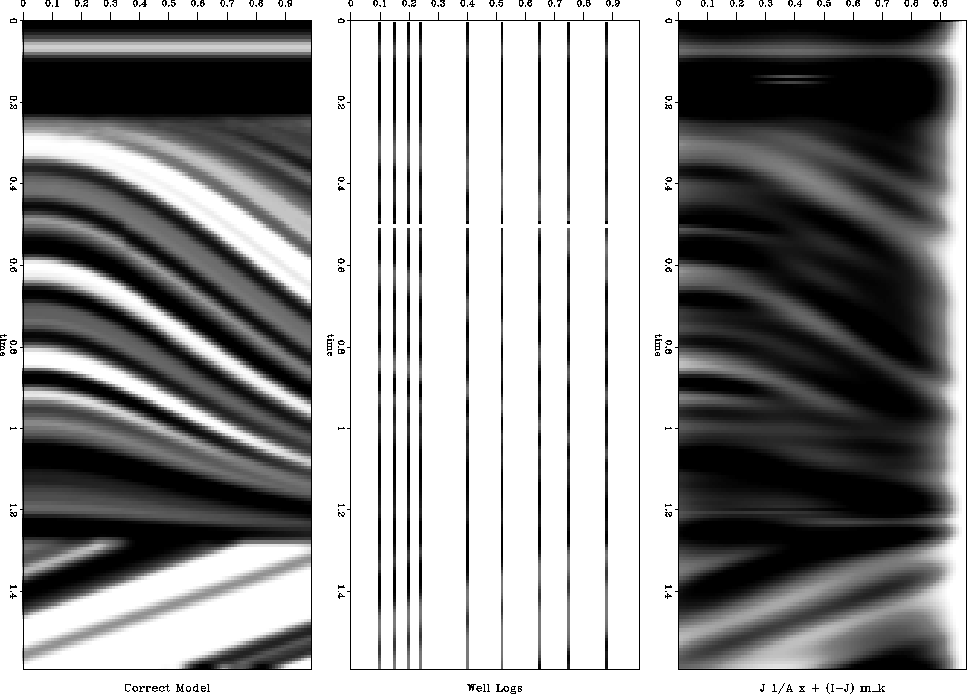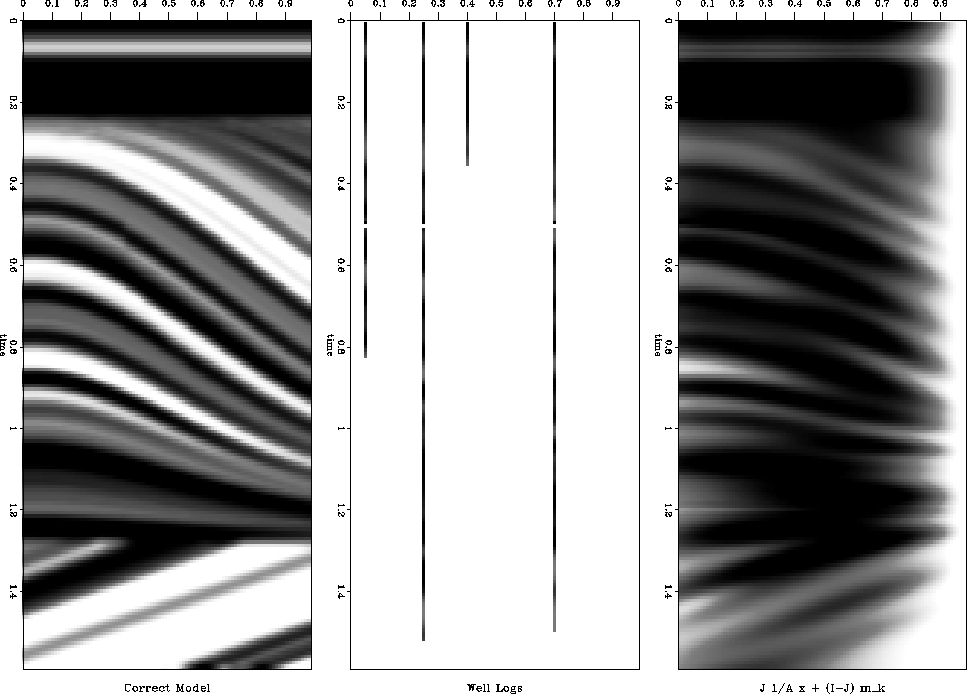




Next: SHOT-GATHER BASED INTERPOLATION
Up: Clapp, et al.: Steering
Previous: Space variable filters
To illustrate the effectiveness of this method
imagine a simple interpolation problem.
Following the methodology of Fomel et al. (1997) we first bin the
data, producing
a model  , composed of known data
, composed of known data  and unknown data
and unknown data
 . We
have an operator
. We
have an operator  which is simply a diagonal masking operator with
zeros at known data locations and ones at unknown locations. We can write
which is simply a diagonal masking operator with
zeros at known data locations and ones at unknown locations. We can write
 and
and  in terms of
in terms of  and
and  ,
,
|  |
(16) |
| (17) |
where  is the identity matrix.
We have the preconditioning operator
is the identity matrix.
We have the preconditioning operator  , which applies polynomial
division using the helix methodology. In this case we have a
single equation in our estimation problem,
, which applies polynomial
division using the helix methodology. In this case we have a
single equation in our estimation problem,
|  |
(18) |
So the only question that remains is what to use for  , or
more specifically
, or
more specifically  ,
,  .
.
For this experiment
we create a series of well logs by subsampling a 2-D velocity field.
We use as our a priori information source, reflector dips,
to build our steering filters, and thus our operator  .
For this test we pick our dips from our ``goal'',
left portion of Figure 5.
We define areas in which we believe each of these dips to be
approximately correct, and smooth the overall
field (right portion of Figure 5).
.
For this test we pick our dips from our ``goal'',
left portion of Figure 5.
We define areas in which we believe each of these dips to be
approximately correct, and smooth the overall
field (right portion of Figure 5).
qdome-reflectors
Figure 5 Left, a synthetic seismic section with
four picked reflectors indicated by '*'; right; the dip field constructed from the picked reflectors.





For the first test, we simulate nine well logs along the survey
(Figure 6). We use equation (18) as our
fitting goal and a conjugate gradient solver to estimate  .Within 12 iterations we have a satisfactory
solution(Figure 6).
If you look closely, especially near the bottom of the section you
can still see the well locations, but in general the solution
converges quickly to something
fairly close to the correct velocity field (Figure 5).
.Within 12 iterations we have a satisfactory
solution(Figure 6).
If you look closely, especially near the bottom of the section you
can still see the well locations, but in general the solution
converges quickly to something
fairly close to the correct velocity field (Figure 5).
qdome-combo1
Figure 6 Left, correct velocity field; middle, well subset selected as input;
right, velocity field resulting from interpolation.





For a more difficult test, we decreased the number of wells, and give
them varying lengths.
In Figure 7 you see that in a few iterations
we achieve a result quite similar
to our goal. In addition, in areas far away from known data the method
still followed the general dip direction simply at a lower frequency level.
qdome-combo4
Figure 7 Left model (our goal), middle well logs, and right estimated model
after 12 iterations.










Next: SHOT-GATHER BASED INTERPOLATION
Up: Clapp, et al.: Steering
Previous: Space variable filters
Stanford Exploration Project
9/12/2000
![]() .
For this test we pick our dips from our ``goal'',
left portion of Figure 5.
We define areas in which we believe each of these dips to be
approximately correct, and smooth the overall
field (right portion of Figure 5).
.
For this test we pick our dips from our ``goal'',
left portion of Figure 5.
We define areas in which we believe each of these dips to be
approximately correct, and smooth the overall
field (right portion of Figure 5).

![]() .Within 12 iterations we have a satisfactory
solution(Figure 6).
If you look closely, especially near the bottom of the section you
can still see the well locations, but in general the solution
converges quickly to something
fairly close to the correct velocity field (Figure 5).
.Within 12 iterations we have a satisfactory
solution(Figure 6).
If you look closely, especially near the bottom of the section you
can still see the well locations, but in general the solution
converges quickly to something
fairly close to the correct velocity field (Figure 5).

